Investment Appraisal: NPV, Payback Period & Decision Making
VerifiedAdded on 2023/06/11
|7
|1378
|52
Essay
AI Summary
This essay provides a comparative analysis of Net Present Value (NPV) and payback period methods in business decision-making, focusing on their application in evaluating investment proposals. It calculates the payback period for Project A (Silicone Cutleries) and Project B (Non-Stick Cutleries), determining that Project A has a slightly shorter payback period. The essay then calculates the NPV for both projects, revealing a higher NPV for Project B, suggesting it as the preferred investment based on this metric. The analysis further explores the role of financial factors like project cost, cash flow, and business nature, as well as non-financial factors such as human, managerial, and legal considerations in aiding decision-making. The conclusion emphasizes the usefulness of both discounting and non-discounting techniques in investment appraisal, highlighting the trade-off between quicker cost recovery (payback period) and higher overall returns (NPV).

BUSINESS DECISION
MAKING
MAKING
Paraphrase This Document
Need a fresh take? Get an instant paraphrase of this document with our AI Paraphraser
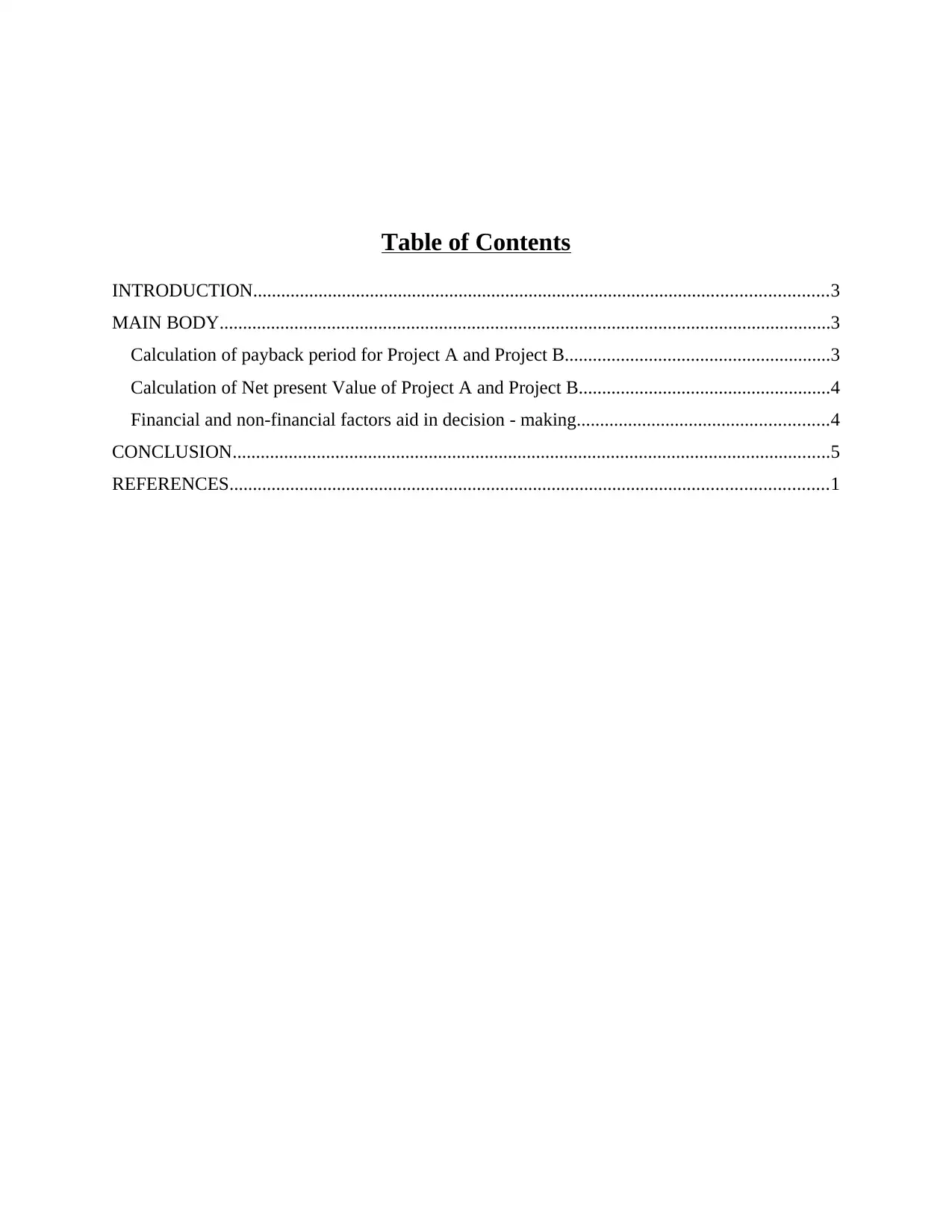
Table of Contents
INTRODUCTION...........................................................................................................................3
MAIN BODY...................................................................................................................................3
Calculation of payback period for Project A and Project B.........................................................3
Calculation of Net present Value of Project A and Project B......................................................4
Financial and non-financial factors aid in decision - making......................................................4
CONCLUSION................................................................................................................................5
REFERENCES................................................................................................................................1
INTRODUCTION...........................................................................................................................3
MAIN BODY...................................................................................................................................3
Calculation of payback period for Project A and Project B.........................................................3
Calculation of Net present Value of Project A and Project B......................................................4
Financial and non-financial factors aid in decision - making......................................................4
CONCLUSION................................................................................................................................5
REFERENCES................................................................................................................................1
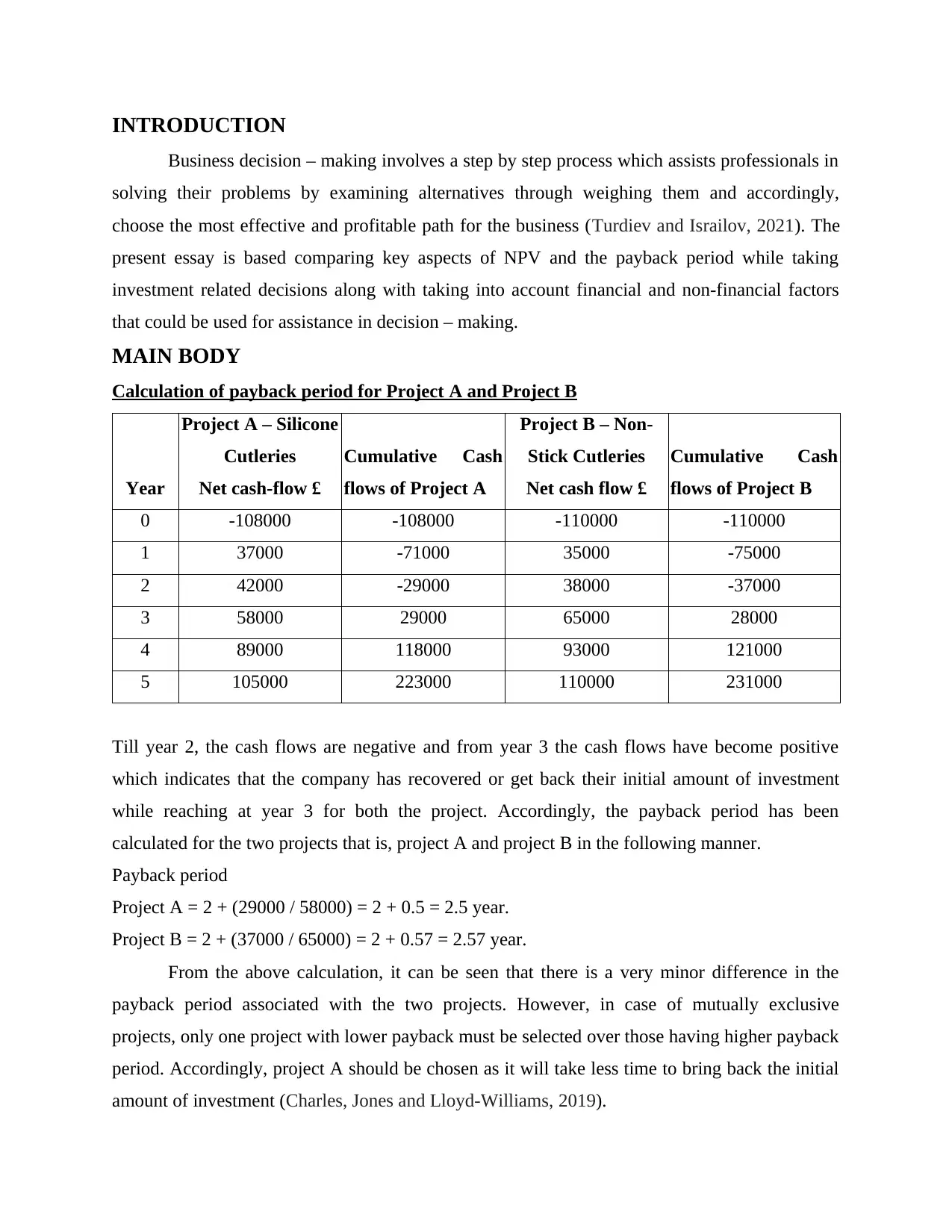
INTRODUCTION
Business decision – making involves a step by step process which assists professionals in
solving their problems by examining alternatives through weighing them and accordingly,
choose the most effective and profitable path for the business (Turdiev and Israilov, 2021). The
present essay is based comparing key aspects of NPV and the payback period while taking
investment related decisions along with taking into account financial and non-financial factors
that could be used for assistance in decision – making.
MAIN BODY
Calculation of payback period for Project A and Project B
Year
Project A – Silicone
Cutleries
Net cash-flow £
Cumulative Cash
flows of Project A
Project B – Non-
Stick Cutleries
Net cash flow £
Cumulative Cash
flows of Project B
0 -108000 -108000 -110000 -110000
1 37000 -71000 35000 -75000
2 42000 -29000 38000 -37000
3 58000 29000 65000 28000
4 89000 118000 93000 121000
5 105000 223000 110000 231000
Till year 2, the cash flows are negative and from year 3 the cash flows have become positive
which indicates that the company has recovered or get back their initial amount of investment
while reaching at year 3 for both the project. Accordingly, the payback period has been
calculated for the two projects that is, project A and project B in the following manner.
Payback period
Project A = 2 + (29000 / 58000) = 2 + 0.5 = 2.5 year.
Project B = 2 + (37000 / 65000) = 2 + 0.57 = 2.57 year.
From the above calculation, it can be seen that there is a very minor difference in the
payback period associated with the two projects. However, in case of mutually exclusive
projects, only one project with lower payback must be selected over those having higher payback
period. Accordingly, project A should be chosen as it will take less time to bring back the initial
amount of investment (Charles, Jones and Lloyd-Williams, 2019).
Business decision – making involves a step by step process which assists professionals in
solving their problems by examining alternatives through weighing them and accordingly,
choose the most effective and profitable path for the business (Turdiev and Israilov, 2021). The
present essay is based comparing key aspects of NPV and the payback period while taking
investment related decisions along with taking into account financial and non-financial factors
that could be used for assistance in decision – making.
MAIN BODY
Calculation of payback period for Project A and Project B
Year
Project A – Silicone
Cutleries
Net cash-flow £
Cumulative Cash
flows of Project A
Project B – Non-
Stick Cutleries
Net cash flow £
Cumulative Cash
flows of Project B
0 -108000 -108000 -110000 -110000
1 37000 -71000 35000 -75000
2 42000 -29000 38000 -37000
3 58000 29000 65000 28000
4 89000 118000 93000 121000
5 105000 223000 110000 231000
Till year 2, the cash flows are negative and from year 3 the cash flows have become positive
which indicates that the company has recovered or get back their initial amount of investment
while reaching at year 3 for both the project. Accordingly, the payback period has been
calculated for the two projects that is, project A and project B in the following manner.
Payback period
Project A = 2 + (29000 / 58000) = 2 + 0.5 = 2.5 year.
Project B = 2 + (37000 / 65000) = 2 + 0.57 = 2.57 year.
From the above calculation, it can be seen that there is a very minor difference in the
payback period associated with the two projects. However, in case of mutually exclusive
projects, only one project with lower payback must be selected over those having higher payback
period. Accordingly, project A should be chosen as it will take less time to bring back the initial
amount of investment (Charles, Jones and Lloyd-Williams, 2019).
⊘ This is a preview!⊘
Do you want full access?
Subscribe today to unlock all pages.

Trusted by 1+ million students worldwide
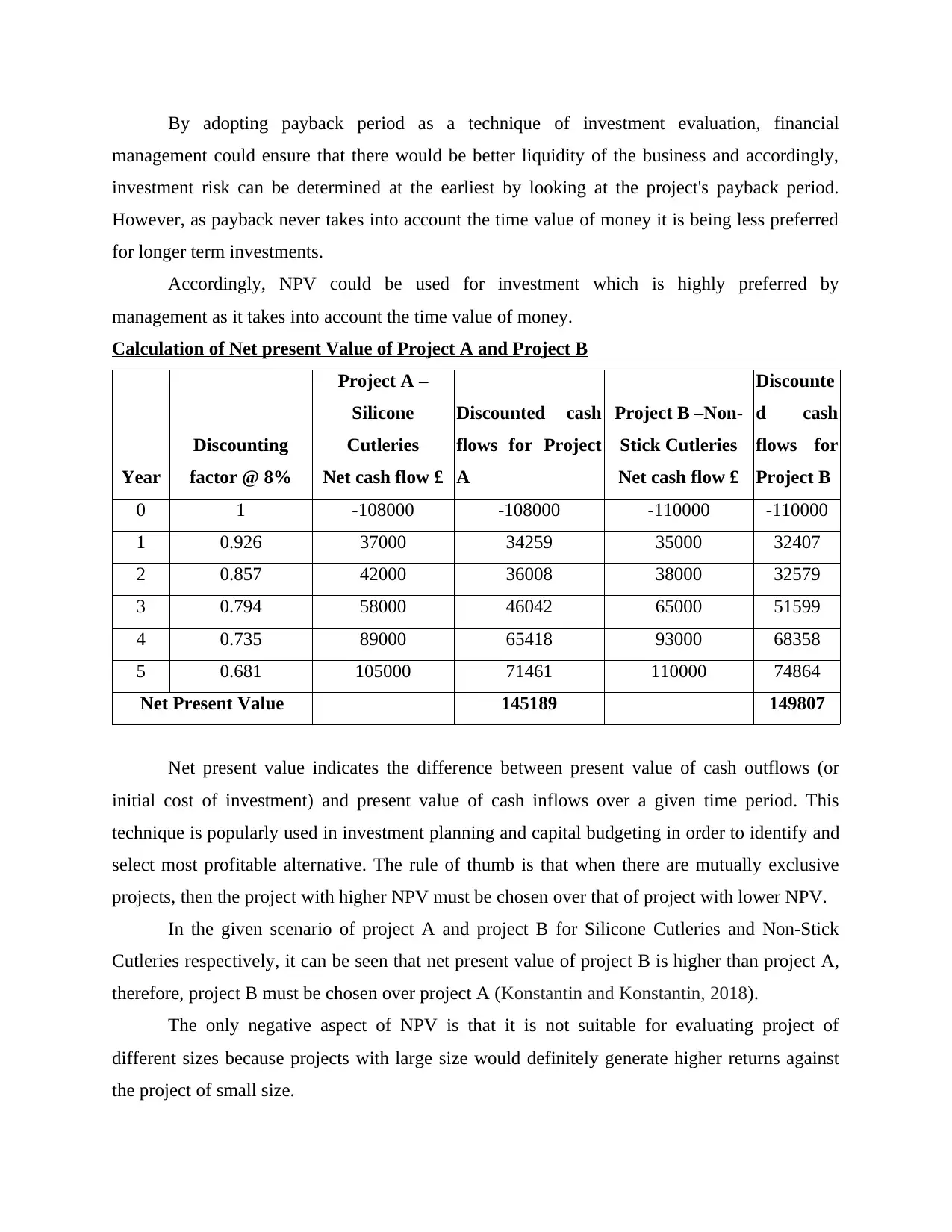
By adopting payback period as a technique of investment evaluation, financial
management could ensure that there would be better liquidity of the business and accordingly,
investment risk can be determined at the earliest by looking at the project's payback period.
However, as payback never takes into account the time value of money it is being less preferred
for longer term investments.
Accordingly, NPV could be used for investment which is highly preferred by
management as it takes into account the time value of money.
Calculation of Net present Value of Project A and Project B
Year
Discounting
factor @ 8%
Project A –
Silicone
Cutleries
Net cash flow £
Discounted cash
flows for Project
A
Project B –Non-
Stick Cutleries
Net cash flow £
Discounte
d cash
flows for
Project B
0 1 -108000 -108000 -110000 -110000
1 0.926 37000 34259 35000 32407
2 0.857 42000 36008 38000 32579
3 0.794 58000 46042 65000 51599
4 0.735 89000 65418 93000 68358
5 0.681 105000 71461 110000 74864
Net Present Value 145189 149807
Net present value indicates the difference between present value of cash outflows (or
initial cost of investment) and present value of cash inflows over a given time period. This
technique is popularly used in investment planning and capital budgeting in order to identify and
select most profitable alternative. The rule of thumb is that when there are mutually exclusive
projects, then the project with higher NPV must be chosen over that of project with lower NPV.
In the given scenario of project A and project B for Silicone Cutleries and Non-Stick
Cutleries respectively, it can be seen that net present value of project B is higher than project A,
therefore, project B must be chosen over project A (Konstantin and Konstantin, 2018).
The only negative aspect of NPV is that it is not suitable for evaluating project of
different sizes because projects with large size would definitely generate higher returns against
the project of small size.
management could ensure that there would be better liquidity of the business and accordingly,
investment risk can be determined at the earliest by looking at the project's payback period.
However, as payback never takes into account the time value of money it is being less preferred
for longer term investments.
Accordingly, NPV could be used for investment which is highly preferred by
management as it takes into account the time value of money.
Calculation of Net present Value of Project A and Project B
Year
Discounting
factor @ 8%
Project A –
Silicone
Cutleries
Net cash flow £
Discounted cash
flows for Project
A
Project B –Non-
Stick Cutleries
Net cash flow £
Discounte
d cash
flows for
Project B
0 1 -108000 -108000 -110000 -110000
1 0.926 37000 34259 35000 32407
2 0.857 42000 36008 38000 32579
3 0.794 58000 46042 65000 51599
4 0.735 89000 65418 93000 68358
5 0.681 105000 71461 110000 74864
Net Present Value 145189 149807
Net present value indicates the difference between present value of cash outflows (or
initial cost of investment) and present value of cash inflows over a given time period. This
technique is popularly used in investment planning and capital budgeting in order to identify and
select most profitable alternative. The rule of thumb is that when there are mutually exclusive
projects, then the project with higher NPV must be chosen over that of project with lower NPV.
In the given scenario of project A and project B for Silicone Cutleries and Non-Stick
Cutleries respectively, it can be seen that net present value of project B is higher than project A,
therefore, project B must be chosen over project A (Konstantin and Konstantin, 2018).
The only negative aspect of NPV is that it is not suitable for evaluating project of
different sizes because projects with large size would definitely generate higher returns against
the project of small size.
Paraphrase This Document
Need a fresh take? Get an instant paraphrase of this document with our AI Paraphraser
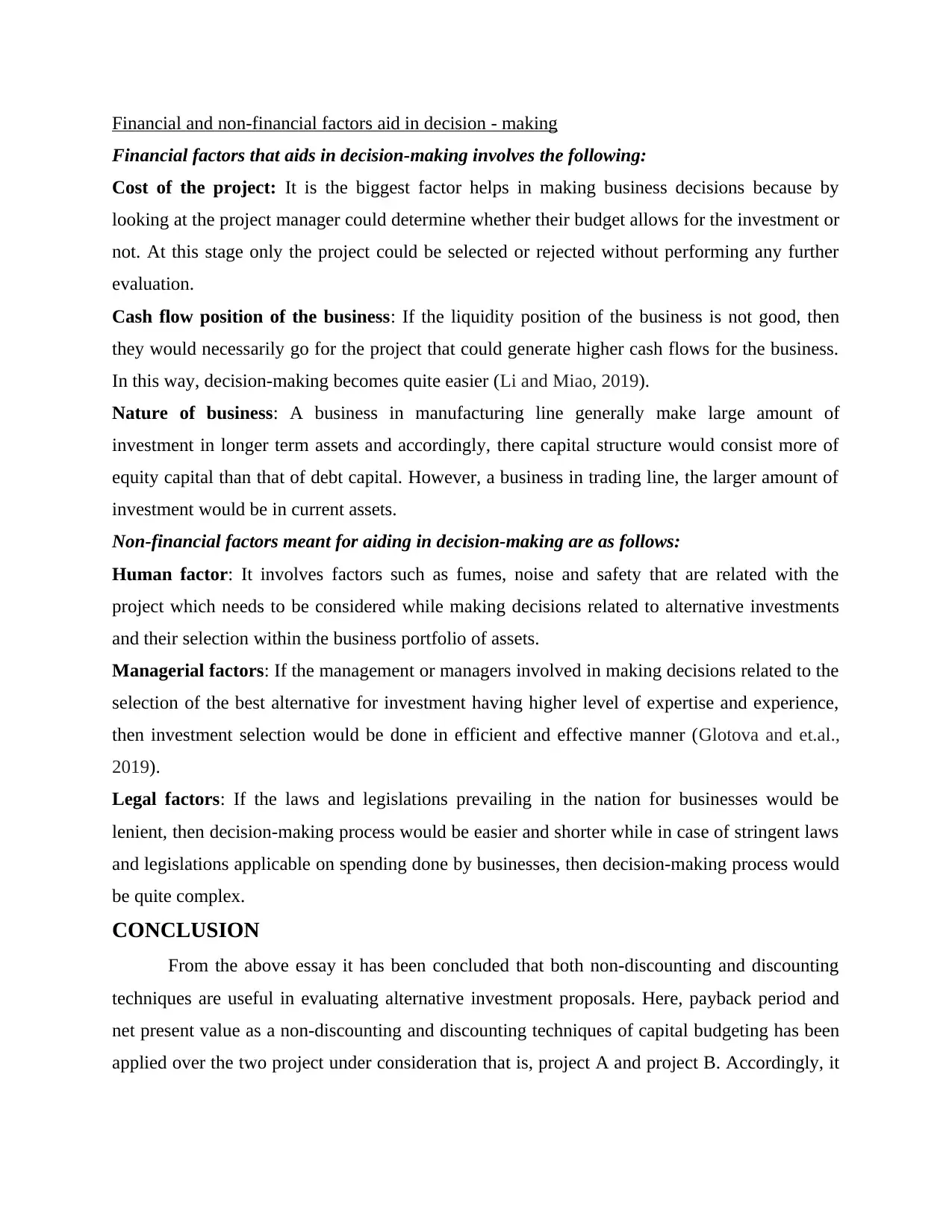
Financial and non-financial factors aid in decision - making
Financial factors that aids in decision-making involves the following:
Cost of the project: It is the biggest factor helps in making business decisions because by
looking at the project manager could determine whether their budget allows for the investment or
not. At this stage only the project could be selected or rejected without performing any further
evaluation.
Cash flow position of the business: If the liquidity position of the business is not good, then
they would necessarily go for the project that could generate higher cash flows for the business.
In this way, decision-making becomes quite easier (Li and Miao, 2019).
Nature of business: A business in manufacturing line generally make large amount of
investment in longer term assets and accordingly, there capital structure would consist more of
equity capital than that of debt capital. However, a business in trading line, the larger amount of
investment would be in current assets.
Non-financial factors meant for aiding in decision-making are as follows:
Human factor: It involves factors such as fumes, noise and safety that are related with the
project which needs to be considered while making decisions related to alternative investments
and their selection within the business portfolio of assets.
Managerial factors: If the management or managers involved in making decisions related to the
selection of the best alternative for investment having higher level of expertise and experience,
then investment selection would be done in efficient and effective manner (Glotova and et.al.,
2019).
Legal factors: If the laws and legislations prevailing in the nation for businesses would be
lenient, then decision-making process would be easier and shorter while in case of stringent laws
and legislations applicable on spending done by businesses, then decision-making process would
be quite complex.
CONCLUSION
From the above essay it has been concluded that both non-discounting and discounting
techniques are useful in evaluating alternative investment proposals. Here, payback period and
net present value as a non-discounting and discounting techniques of capital budgeting has been
applied over the two project under consideration that is, project A and project B. Accordingly, it
Financial factors that aids in decision-making involves the following:
Cost of the project: It is the biggest factor helps in making business decisions because by
looking at the project manager could determine whether their budget allows for the investment or
not. At this stage only the project could be selected or rejected without performing any further
evaluation.
Cash flow position of the business: If the liquidity position of the business is not good, then
they would necessarily go for the project that could generate higher cash flows for the business.
In this way, decision-making becomes quite easier (Li and Miao, 2019).
Nature of business: A business in manufacturing line generally make large amount of
investment in longer term assets and accordingly, there capital structure would consist more of
equity capital than that of debt capital. However, a business in trading line, the larger amount of
investment would be in current assets.
Non-financial factors meant for aiding in decision-making are as follows:
Human factor: It involves factors such as fumes, noise and safety that are related with the
project which needs to be considered while making decisions related to alternative investments
and their selection within the business portfolio of assets.
Managerial factors: If the management or managers involved in making decisions related to the
selection of the best alternative for investment having higher level of expertise and experience,
then investment selection would be done in efficient and effective manner (Glotova and et.al.,
2019).
Legal factors: If the laws and legislations prevailing in the nation for businesses would be
lenient, then decision-making process would be easier and shorter while in case of stringent laws
and legislations applicable on spending done by businesses, then decision-making process would
be quite complex.
CONCLUSION
From the above essay it has been concluded that both non-discounting and discounting
techniques are useful in evaluating alternative investment proposals. Here, payback period and
net present value as a non-discounting and discounting techniques of capital budgeting has been
applied over the two project under consideration that is, project A and project B. Accordingly, it

has been determined that project A will bring back initial cost of investment earlier while project
B will generate higher returns.
B will generate higher returns.
⊘ This is a preview!⊘
Do you want full access?
Subscribe today to unlock all pages.

Trusted by 1+ million students worldwide
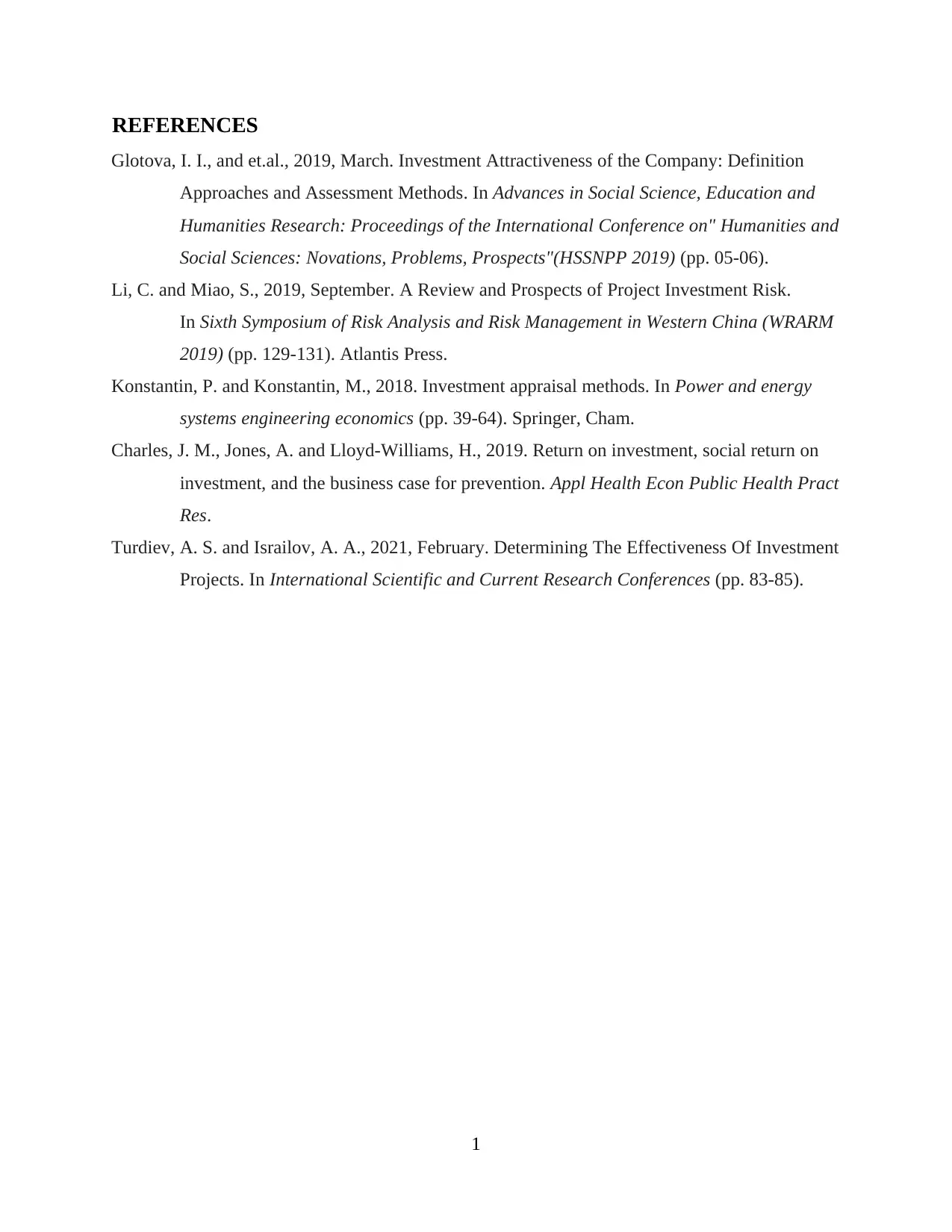
REFERENCES
Glotova, I. I., and et.al., 2019, March. Investment Attractiveness of the Company: Definition
Approaches and Assessment Methods. In Advances in Social Science, Education and
Humanities Research: Proceedings of the International Conference on" Humanities and
Social Sciences: Novations, Problems, Prospects"(HSSNPP 2019) (pp. 05-06).
Li, C. and Miao, S., 2019, September. A Review and Prospects of Project Investment Risk.
In Sixth Symposium of Risk Analysis and Risk Management in Western China (WRARM
2019) (pp. 129-131). Atlantis Press.
Konstantin, P. and Konstantin, M., 2018. Investment appraisal methods. In Power and energy
systems engineering economics (pp. 39-64). Springer, Cham.
Charles, J. M., Jones, A. and Lloyd-Williams, H., 2019. Return on investment, social return on
investment, and the business case for prevention. Appl Health Econ Public Health Pract
Res.
Turdiev, A. S. and Israilov, A. A., 2021, February. Determining The Effectiveness Of Investment
Projects. In International Scientific and Current Research Conferences (pp. 83-85).
1
Glotova, I. I., and et.al., 2019, March. Investment Attractiveness of the Company: Definition
Approaches and Assessment Methods. In Advances in Social Science, Education and
Humanities Research: Proceedings of the International Conference on" Humanities and
Social Sciences: Novations, Problems, Prospects"(HSSNPP 2019) (pp. 05-06).
Li, C. and Miao, S., 2019, September. A Review and Prospects of Project Investment Risk.
In Sixth Symposium of Risk Analysis and Risk Management in Western China (WRARM
2019) (pp. 129-131). Atlantis Press.
Konstantin, P. and Konstantin, M., 2018. Investment appraisal methods. In Power and energy
systems engineering economics (pp. 39-64). Springer, Cham.
Charles, J. M., Jones, A. and Lloyd-Williams, H., 2019. Return on investment, social return on
investment, and the business case for prevention. Appl Health Econ Public Health Pract
Res.
Turdiev, A. S. and Israilov, A. A., 2021, February. Determining The Effectiveness Of Investment
Projects. In International Scientific and Current Research Conferences (pp. 83-85).
1
1 out of 7
Related Documents
Your All-in-One AI-Powered Toolkit for Academic Success.
+13062052269
info@desklib.com
Available 24*7 on WhatsApp / Email
![[object Object]](/_next/static/media/star-bottom.7253800d.svg)
Unlock your academic potential
Copyright © 2020–2025 A2Z Services. All Rights Reserved. Developed and managed by ZUCOL.


